

| Invertebrate news 2019 |
| Insect and Arachnid related news from around Nottinghamshire |
| Want your interesting or notable Nottinghamshire sightings listed? email tpendleton@eakringbirds.com |
|
Further records of Clumber Park's Diamond Spider The discovery of this spider on heathland at Clumber Park back in 2017, withoubt any doubt, represents one of the county's most unexpected and surprising invertebrate records of recent years. Thanatus formicinus (Clerck, 1747) is often referred to as the Diamond Spider by the media, and was thought to have been extinct in the UK since 1969, but it appears to be doing well, following the results of targetted surveys run by the British Arachnological Survey, undertaken in the area of the original iscovery. It was only previously known from a handful of sites in southern counties and was believed to have become extinct in the UK more than 50 years ago. According to the Spider Recording Scheme's website, it was recorded in 1894 near Brockenhurst in the New Forest and from two sites in Ashdown Forest, East Sussex in the 20th century. |
|
| ... |
|
It was apparently well-established when found in Ashdown Forest, but
searches in recent years have not rediscovered the spider and the
habitats there are thought to have become less suitable. It is a widespread species in western and central
parts of Europe. More recently there have been additional records from Clumber, following surveys organised by the BAS. These were mostly carried out in the same area as the original find, but did include nearby locations like the RSPB's Budby South Forest reserve. I visited Clumber in October and after several attempts lifting up suitable looking heather, found the first of two similar sized specimens after about ten minutes. These both proved to be immature. Thanatus formicinus is typically found underneath heather, especially where heather is growing into grass and easily lifted up. |
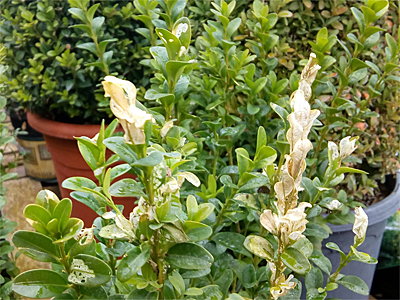 |
Some larval records of the Box Tree Moth Two recent (and possibly the county's first) records of Box Tree Moth Cydalima perspectalis larva, have come from two sites within a few miles of each other. On August 16th, while visiting the former Floralands Garden Centre at Lambley, a number of small Box (Buxus sempervirens) hedging plants were found to have the distinctive feeding signs (showed left) of Box Tree Moth. Further inspection quickly revealed a number of larva within their 'tent-like' retreats. Then only a few miles away, larvae were found present on a single Box growing in the front garden of a house on Gretton Road, Mapperley, so clearly the moth must be fairly well established in Nottinghamshire now. |
|
| ... | ||
| Nottinghamshire's first record of Cydalima perspectalis Box Tree Moth came from Sean Tobin's MV light at Bestwood Village on 05/07/18. Originally an Asian species, Box Tree Moth was first recorded from the UK as recently as 2008 and was probably introduced here via the horticultural trade. It is firmly established in the London area and now seems to be spreading rapidly north. Regarded as a pest species of Box (Buxus sp), the Bestwood Village record occurred about a fortnight before another was recorded by David and Veronica McGeever at Ravenshead on 17/07/18. Then quite remarkably, a third was trapped by Rob Woodward on 10/10/18 at the Bagthorpe Garden Allotments in Sherwood, Nottingham. | ||
|
Some recent Nottinghamshire moth records Its been a quite remarkable year for moths in the county. Aside from still poor numbers of a number of generally common species at many recorders traps, the county has recently seen a number of rare moths turn up, including new species for Nottinghamshire and a number of rare migrants. Phil Cadman, Ian Hunt and Melanie Newman of the Idle Valley Lepidoptera Study Group (Lound Moth Group) produced two remarkable county firsts in the form of both Kent Black Arches Meganola albula ([Denis & Schiffermüller], 1775) and the colourful (and equally rare) Oncocerus semirubella (Scopoli, 1763) on August 1st. Phil also recorded what's believed to be the county's first Leek Moth Acrolepiopsis assectella (Zeller, 1839) from his Worksop garden on July 28th, showing the benefits of running a trap from home, even if only for a couple of hours. |
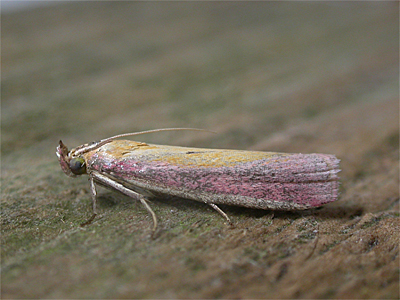 |
|
|
Earlier
in July, Phil Lee recorded another Least Carpet
Idaea rusticata ([Denis & Schiffermüller], 1775)
from
his Misterton garden (third Nottinghamshire record, unless it turned up
elsewhere this year) and there was another Light Knot-grass
Acronicta menyanthidis (Esper, 1798) trapped by Oliver Beacock at
Barnby on June 30th. On the migrant front, Sean Tobin recorded a Bedstraw Hawk-moth Hyles gallii (Rottemburg, 1775) to his garden MV at Bestwood Village on August 1st and reports trapping another Box Tree Moth Cydalima perspectalis (Walker, 1859) in July, the rare Pyralid Loxostege sticticalis was trapped at Elkesley on July 30th by Paul Coombes (via Twitter) looking as though its only the second record for Nottinghamshire. |
||
| The Harvestman Leiobunum sp.A recorded at Bramcote Jonathan Campbell has reported another site for Leiobunum sp.A, from the walls of a Bramcote house. The well documented record Jonathan sent us, included a photograph showing a sub-adult male which had been found indoors after a thunderstorm. This very large (and still scientifically un-named) Harvestman, first appeared in The Netherlands in 2004 and is believed to have been introduced into Europe via importation. Although an invasive species, often forming large congregations numbering hundreds of individuals on the shaded walls of buildings, we have seen no evidence from our own studies and observations, to suggest that its arrival here has had any negative impact on our native Harvestmen, or our other well established, non-native species Opilio canestrinii and Dicranopalpus ramosus. We found the first ever record for the UK, on the walls of a Worksop house in October 2009 and then at Worksop Priory three years later. In 2018, a single male found at a garden centre at Oxton by Wil Heeney, represented the third site in the county. Clearly more are out there. |
|
A record of the European Paper Wasp from Colwick Darren Matthews reports finding and photographing (right) what seems to be Nottinghamshire's first record of the European Paper Wasp Polistes dominula (Christ, 1791). Polistes dominula is widely distributed across southern and central parts of Europe, but in the UK occurs largely as an accidental import or rare vagrant. It is known to have bred in the Thames Corridor area of south-east England and is sometimes regarded as a transient breeder in the UK. There are few records and the Colwick one, certainly represents the most northerly UK record, but it has occurred in neighbouring Leicestershire within the past few years. Despite being social wasps, nests are small and usually constructed within the roofspaces of buildings. Nests last from April to as late as October and November, with only young Queens overwintering. |
|
|
| Further records of Brassica Bug and
Forget-me-not Shieldbug from Toton Barry Lygo has recorded Nottinghamshire's third record of Brassica Bug Eurydema oleracea (Linnaeus, 1758) on Garlic Mustard at Toton on June 27th, quickly following the county's first from Colwick Racecourse and Colwick CP earlier in May (Matthews, D.). Barry has also recorded Forget-me-not Shieldbug Sehirus luctuosus (Mulsant & Rey, 1866), annually from his Toton garden each Spring since 2008. This now makes three Nottinghamshire sites where it has occurred. Sehirus luctuosus was first recorded in Nottinghamshire from Warsop Main Pit Top in 2007 (Pendleton, T.A. and Pendleton, D.T.), followed by two records from a brownfield site at Langar in 2015. As it's name suggests, it is associated with Forget-me-not and adults occur from August and over-winter. |
| Painted Ladies moving north Painted Ladies are currently moving north through Nottinghamshire and other Midlands counties. Our first of the year was recorded as early as April 28th, from Sherwood Forest, which may have been a fore-runner of an increase in numbers during the latter part of June. We had no further records during May, even though there were some reports of huge numbers in parts of the Meditteranean on social media. Best numbers (or at least the most obvious movement) was on June 27th. We recorded single Painted Ladies moving north during a car journey from Pinxton to Market Warsop, with Painted Ladies recorded at Sutton-in-Ashfield, Huthwaite, two sites in Mansfield Woodhouse and King's Mill Hospital. Numbers are nowhere near those of the huge migrations experienced during Spring 1996 and 2009, but there is potential for much better counts to come. |
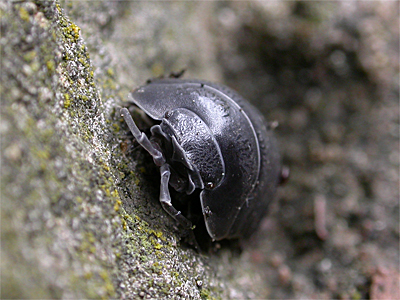 |
Some recent notable records from around the county Our own observations suggest that there are far fewer invertebrates of all Orders, around this year. After another extremely mild Winter which produced a few (temporary) flakes of snow on one day, occasional frosts and then a period of fine, warm weather in February, it looked like 2019 would be a good year for invertebrates. But then it cooled down again, although remaining largely very dry here through April and May, but then it rained in early June and at the time of writing (June 18th) still shows little sign of becoming drier in the long term. In the field, there have been very few insects generally, but some species have clearly done very well and there have already been a number of recent additions to the county list. Details of these can be found by reading through the various news items below, but we thought it would be of interest if we listed the other recent notable records here. |
|
| ... | ||
|
Hemiptera - A second county record of Tortoise Sheildbug Eurygaster testudinaria from Gedling CP and found by Mark Tyler, following on from the first record for Nottinghamshire found by Darren Matthews at the same site on May 23rd. Diptera - Two records of the Cranefly Ctenophora pectinicornis (Tipulidae) with a record from Hollinwell Golf Course on June 4th, which was recorded by Nicholas Jones and Phil Stain (per Sheila Wright) and another photographed by Ken Lomas on June 17th, which we are awaiting further details of. Peter Smith has recorded Terellia longicauda, Trypeta zoe (both Tephritidae) and Black Colonel Odontomyia tigrina (Stratiomyidae) from Netherfield Ash Lagoons, which looks to be the second Nottinghamshire record, although there is a 1925 record from the Newark area listed on the NBN Atlas, but that record is undated, rather vague in that the grid reference is just SK75 and has no recorder or determiner attached to it. Coleoptera - At Attenborough NR, reserve manager Tim Sexton recorded Anthocomus fasciatus on May 1st (possible second county record) and Dasytes virens on June 18th and Phil Lee found the Longhorns Phytoecia cylindrica at the Idle Valley NR on May 23rd and Pseudovadonia livida at Idle Stop on June 18th. Other sightings - There have been several Snake Fly (Rhaphidoptera) records, which is unusual for Nottinghamshire. Tim Sexton and Darren Matthews both recorded Xanthostigma xanthostigma at Attenborough NR on May 13th and June 16th respectively, representing the NWT reserve's first records. Snake Flies are unusual to say the least away from the Sherwood Forest area, where Sean Browne found Phaetostigma notata on Scot's Pine on Budby South Forest on June 9th. The large Woodlouse Armadillidium depressum has been recorded from a further two sites in Nottinghamshire, bringing the total number of known sites to four. David Shaw reported it from a railway bridge at Marnham on June 1st, whilst we found several large adults and numerous juveniles underneath loose mortar along an old stone wall opposite Sainsburys on Perry Road in New Basford on June 16th. |
||
|
First record of Goat Moth for the Idle Valley NR Goat Moth Cossus cossus (Linnaeus, 1758) is one moth which continues to elude most of the county's moth trappers. Few have ever seen it in the county and since being refound here in 2013, there have been few other records. Always an extremely rare moth in Nottinghamshire,
all recent records have come from a handful of sites in the far north of the county.
The latest one to turn up, was a pristine male, which was trapped by Ian
Hunt and Melanie Newman, of the Lound Moth Group on June 5th 2019. |
|
|
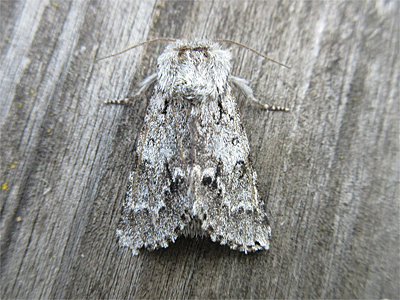 |
Light Knot Grass in Nottinghamshire An unusual series of Light Knot Grass Acronicta menyanthidis (Esper, 1798) records, took place at the end of May 2019. Of the records made public via social media, were two from just over the county border in South Yorkshire and Lincolnshire. Then we were contacted by Pete Leonard from Leicestershire, informing us of one he'd trapped at Bottesford on May 25th. Frustratingly this was just out of VC56, but a few days later, Pete informed us of a Nottinghamshire record from the same night. It was recorded by Mike Hill and Tom Shields, who were running a trap at Netherfield Ash Lagoons for the Netherfield Wildlife Group on May 24th and is the first Nottinghamshire record since the publication of Carr's book in 1916. Light Knot Grass is a northern species, typically of damp heathland and moorland. Our thanks go to Pete Leonard of Harby in Leicestershire, for very kindly supplying us with his photograph of the Bottesford moth. |
|
| The treehopper Centrotus cornutus
recorded at Eaton Wood Phil Lee has recorded what seems to be the county's first record in almost a century, of Centrotus cornutus (Linnaeus, 1758) from the NWT's Eaton Wood reserve near Retford. The NBN Atlas lists a 1925 record from woodland near Kneesall, but we are unable to trace any other records until the one found by Phil near the entrance to Eaton Wood on May 29th. Centrotus cornutus is one of two species of treehopper (Membracidae) known from the UK and is the more widespread of the two, although not commonly found anywhere. |
| A
second new Shieldbug for Nottinghamshire Following hot on the heels of finding Nottinghamshire's first ever Brassica Bug at Colwick CP, the same observer has struck again, this time finding Nottinghamshire's first Tortoise Bug at Gedling CP. Having been expanding its northerly UK range for a number of years, this was one species which we had predicted as being one of the most likely to arrive here a few weeks previously. Tortoise Bug Eurygaster testudinaria (Geoffroy, 1785) reached neighbouring Leicestershire in 2016, when recorded from Ketton Quarry (Nightingale, K.) and finally reached Nottinghamshire in May 2019, when Darren Matthews found and photographed this one at Gedling CP, around a week after finding Nottinghamshire's first Brassica Bug at nearby Colwick CP. Its a classic example of how rewarding hours of fieldwork can be for an observer who puts in the time. Although Darren admitted that it literally landed in front of him, he still had to be there to witness it. |
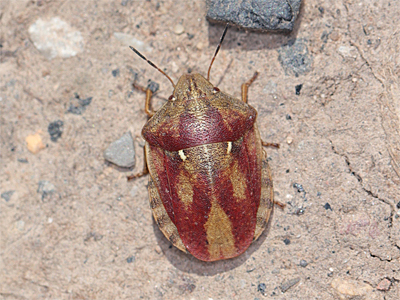 |
|
| Another new Weevil for Attenborough NR and Nottinghamshire
Reserve manager Tim Sexton continues to turn up new species for the county, at the Nottinghamshire Wildlife Trust's Attenborough NR. Tim's latest find is the weevil Thryogenes scirrhosus (Gyllenhal, 1836), a generally uncommon speces found at a number of localities, scattered over much of the southern UK. Found by Tim in May 2019, Thryogenes scirrhosus favours waterside vegetation, where it can be found on plants such as Common Club Rush (Schoenoplectus lacustris) and Branched Burr-reed (Sparganium erectum). |
||
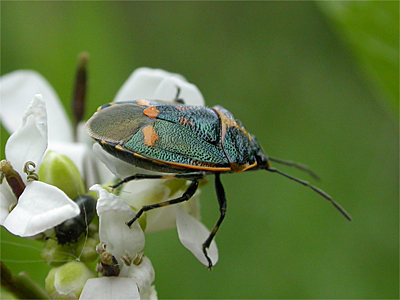 |
Brassica Bug recorded at Colwick After recent records from the neighbouring counties of Leicestershire, Lincolnshire and South Yorkshire, Brassica Bug Eurydema oleracea (Linnaeus, 1758) has finally been recorded in Nottinghamshire. Brassica Bug had been spreading steadily north from southern counties of the UK for a number of years, but progress seemed to slow, following Leicestershire's first records in 2015 and Lincolnshire's first the following year. It seems to have had a good year in 2018, which possibly allowed further range expansion and was finally eventually recorded from Nottinghamshire on May 16th, when three adults were found by Darren Matthews, on Garlic Mustard at Colwick Racecourse. The adults come in several colour forms, where the white markings can be replaced by either red or yellow and are found on a range of Brassicas including plants such as Garlic Mustard and Horse Radish. In view of the Colwick record, further reports from other sites in VC56 Nottinghamshire should soon follow. |
|
| A report of Bryony Ladybird from north Nottinghamshire Among the latest invertebrate records posted to iRecord in the early part of this year, has been a record of Bryony Ladybird Henosepilachna argus (Geoffory in Fourcroy, 1762). As far as we know, this would indeed be a first for Nottinghamshire, but the record has yet to be validated and there seems to be no supporting photograph to back up the record from April this year. The record concerns several adults, which were apparently swept from a stretch of grass and low vegetation containing White Bryony (Bryonia dioica), from Carlton-in-Lindrick north of Worksop. Bryony Ladybird is a non-native species, first reported from Oxfordshire in 1997. It spread (or arrived around the same time) into Surrey, but it has never expanded its UK range in the way a number of other non-native species have done in recent years. Bryony Ladybird is very much an urban species, so should be looked for wherever White Bryony grows. Even in the most unlikely of places. |
|
Natural England invertebrate survey produces seven
new species for the Sherwood Forest NNR An invertebrate survey of Sherwood Forest by Natural England's Field Unit in 2018, has revealed that both SSSI's making up the Sherwood Forest NNR are in favourable condition. The survey was carried out between April and October 2018 using a mixture of vane traps, an Owen trap and targeted hand-searching following Webb and Hackman (2018). Sherwood Forest is important for its saproxylic beetles (beetles relying on dead wood for at least part of their life-cycle) are a reportable feature, used for measuring the condition of both the SSSI's. The Birklands and Bilhaugh SSSI generated 270 species records, with 30 of these being saproxylic beetles with conservation status. The survey at Birklands West and Ollerton Corner SSSI, generated a total of 165 records with 20 saproxylic beetle species having conservation status. Both sites were determined to be in favourable condition. |
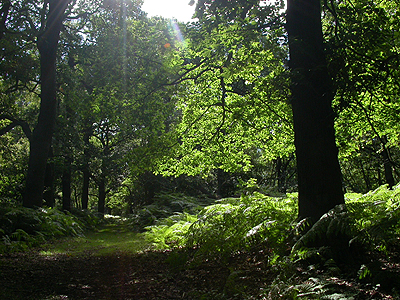 |
|
|
Analysis of the results was undertaken using Pantheon, an online
tool developed by Natural England and the Centre for Ecology and
Hydrology. It provides a consistent and standardised approach to the
assessment of the conservation importance of a sample or a site. Of
the 270 species identified during surveys Pantheon held information
for 241 of these species. 201 (74%) were beetles with the next
largest group being flies with 23 species (8%). The remainder were
bugs, moths, centipedes, hymenoptera, lacewing and molluscs. 115
species were associated with decaying wood of which 107 were
saproxylic beetles. Among the new coleoptera recorded were the
following species: Mycetophagus quadriguttatus - found in vane traps on both SSSIs Xyleborus saxeseni - found in a vane trap at Birklands and Bilhaugh SSSI Cicones variegatus - found in a vane trap at Birklands and Bilhaugh SSSI Haploglossa gentilis - recorded in two traps on both SSSIs Cryptarcha undata (Notable b) - recorded at Birklands West and Ollerton Corner SSSI in a vane trap Leptusa pulchella - in a branch sample at Birklands and Bilhaugh Velleius dilatatus (RDB1) - in a vane trap at Birklands West and Ollerton Corner SSSI |
||
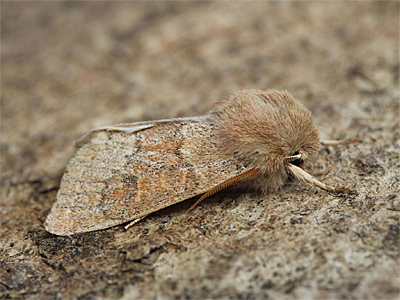 |
First time in Nottinghamshire for around 120 years
- Blossom Underwing recorded at Attenborough NR Reserve manager Tim Sexton was stunned when he found the county's first Blossom Underwing Orthosia miniosa ([Denis & Schiffermüller], 1775) for over a hundred years, in the trap at the Nottinghamshire Wildlife Trust's Attenborough NR on April 21st. Another early flying moth, Blossom Underwing has declined generally from many UK sites over the past number of years and many recent records are thought to refer to migrants from the continent. Tim's record is thought to be the first county record since the late 1800's. It is attracted to MV light and like most other early Spring Noctuids, is especially fond of Sallow blossom. It seems highly unlikely that this moth has ever really been perminently resident in Nottinghamshire |
|
| White-marked in Nottinghamshire Colin Watkin reports trapping and photographing a White-marked (Cerastis leucographa) from his garden at Rampton in north-east Nottinghamshire on April 5th. White-marked is an extremely rare moth in Nottinghamshire and this is only the second modern county record, following two recorded at Sallow blossom in the Misterton area in March 2011 (Wood, N.). Typically flying in March and April, this early flying species is known to occur in scattered woodland localities throughout the southern half of the UK and Wales. It is attracted to MV light and like most other early Spring Noctuids, is especially fond of Sallow blossom. Photographs kindly supplied by Colin Watkin. |
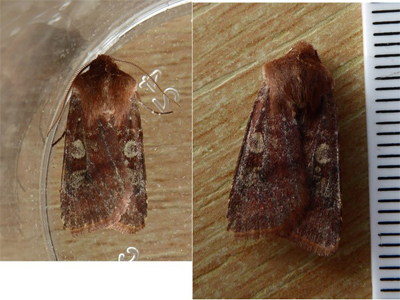 |
|
| Box Bug
at Attenborough again Four years after Nottinghamshire's first record of Box Bug (Gonocerus acuteangulatus) from Attenborough NR in 2015, its finder Tim Sexton has continued to record it locally each year. Tim's last record was in Autumn 2018, but the latest records have recently been reported by Darren Matthews from St Mary's Church at Attenborough, in early April of this year. There is obviously a well established population in the immediate area of both nature reserve and church, so it will be interesting to see how this species spreads through suburban Nottingham in the next few years. |
| Western
Conifer Seed Bug at Lound The first Western Conifer Seed Bug (Leptoglossus occidentalis) record of the year, was reported to us via email recently. Found by Ian Prince in the bathroom of his house at Lound near Retford, the record is very one of the most northerly recorded in Nottinghamshire to date, currently beaten only by one found at Beckingham in December 2014 (du Feu, C.). |
|
Two recent spider records
Tim Sexton reports finding the diminutive, orange/red spider Oonops pulcher (Templeton, 1835) amongst the fungi King Alfred's Cakes at Attenborough Nature Reserve on March 4th. Records away from its main stronghold of Sherwood Forest are extremely unusual and aside from a couple of Clumber Park records in 1996 (Faulds, T.) the spider is known only from the Idle Valley NR in 2000 (Williams, H.). Steatoda nobilis (Thorell, 1875) must be well established in Nottinghamshire and probably more widespread than records indicate. In late 2018, we found a large female (unusually) in a hollow underneath a paving slab at a house on Gretton Road. On March 4th, a distinctive looking web in a conservatory, soon proved that the Noble False Widow is doing well, when a large female was enticed into the open. Despite the continued press reports to the contrary, S. nobilis is not liable to bite and presents no danger to the public. |
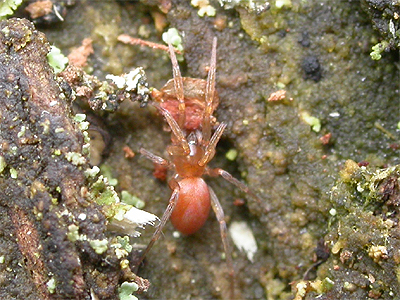 |
|
| A second Nottinghamshire site for the Mirid Bug
Dicyphus escalerae
Tim Sexton reports finding Dicyphus escalerae, on Antirrhinum majus growing in his neighbour's garden at Attenborough on February 11th. Found in Nottinghamshire for the first time in 2018, when recorded from a garden at Mapperley, D. escalerae has been found to remain active throughout the year, based on a number of records we have had throughout the present Winter. It should be looked for wherever Antirrhinum majus is left to grow in gardens for a second or third successive year. |
| Broadholme moths increase the VC56
species list The Nottinghamshire moth list looks set to increase by as many as 31 new species, following confirmation that the gardens of two houses at Broadholme, are in fact in VC56 Nottinghamshire. Martin Gray the South Lincolnshire moth recorder, recently spent a great deal of time with Les Evans from Butterfly Conservation and it came to light that Martin's garden records had not been delegated to the correct VC. Martin's two gardens are actually in VC56 Nottinghamshire and not in VC53 South Lincolnshire. The list of potential additions is purely based on our own list of Nottinghamshire moths available on this website and which will be updated accordingly, to include the species listed below. |
||
| ... |
| 14.100 ... Ectoedemia minimella ... (Zetterstedt, 1839) |
| 10.006 ... Coptotriche angusticollella ... (Duponchel, [1843]) |
| 12.035 ... Niditinea striolella ... (Matsummura, 1931) |
| 17.007 ... Ypsolopha lucella ... (Fabricius, 1775) |
| 32.006 ... Exaerata allisella ... Stainton, 1849 |
| 32.047 ... Depressaria chaerophylli ... Zeller, 1839 |
| 35.003 ... Syncopacma larseniella ... (Gozmany, 1957) |
| 35.066 ... Monochroa tenebrella ... (Hübner, 1817) |
| 35.097 ... Gelechia rhombella ... ([Denis & Schiffermüller], 1775) |
| 37.007 ... Coleophora flavipennella ... (Duponchel, [1843]) |
| 37.050 ... Coleophora albidella ... ([Denis & Schiffermüller], 1775) |
| 37.081 ... Coleophora therinella ... Tengström, 1848 |
| 37.084 ... Coleophora sternipennella ... (Zetterstedt, 1839) |
| 37.104 ... Coleophora adspersella ... Benander, 1939 |
| 38.022 ... Elachista gleichenella ... (Fabricius, 1781) |
| 38.046 ... Elachista albidella ... Nylander, [1848] |
| 49.045 ... Eana osseana ... (Scopoli, 1763) |
| 49.151 ... Apotomis capreana ... (Hübner, 1817) |
| 49.196 ... Bactra lacteana ... Caradja, 1916 |
| 49.229 ... Epinotia caprana ... (Fabricius, 1798) |
| 49.242 ... Epinotia nanana ... (Treitschke, 1835) |
| 49.253 ... Epinotia fraternana ... (Haworth, 1811) |
| 49.259 ... Zeiraphera ratzeburgiana ... (Ratzeburg, 1840) |
| 49.339 ... Cydia servillana ... (Duponchel, 1836) |
| 49.358 ... Grapholita tenebrosana ... (Duponchel, [1843]) |
| 63.002 ... Loxostege sticticalis ... (Linnaeus, 1761) |
| 63.051 ... Antigastra catalaunalis ... (Duponchel, 1833) |
| 70.056 ... Catarhoe cuculata Royal Mantle ... (Hufnagel, 1767) |
| 70.186 ... Eupithecia millefoliata Yarrow Pug ... Rössler, 1866 |
| 73.003 ... Trichoplusia ni Ni Moth ... (Hübner, 1803) |
| 73.297 ... Mythimna albipuncta White-point ... ([Denis & Schiffermüller], 1775) |
| Ectoedemia heringella
found new Nottinghamshire Among a number of lepidoptera records sent to us at the end of 2018, was a record of the leafmining moth Ectoedemia heringella (Mariani, 1839) discovered at Clifton Grove by Jerry Clough in March 2018, and is believed to be the first record for VC56 Nottinghamshire. First discovered in Greater London as recently as 1996, its identity was not confirmed until 2001. Since then, it has spread throughout much of south-eastern England and has reached north Norfolk and now Nottinghamshire. We have failed in our attempts to look for it on a number of occasions over the past few years on Holm Oaks (Quercus ilex) growing in Nottingham Arboretum, Arnot Hill Park, Woodthorpe Park Southwell Minster and Newstead Abbey, but it is very likely to turn up at any of these locations in the coming years. |
||
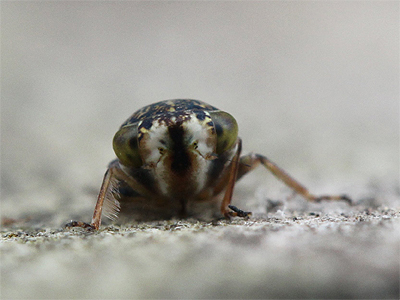 |
Two
new leaf/planthoppers from Attenborough A mild start to the year has proved profitable for Tim Sexton at the Nottinghamshire Wildlife Trust's Attenborough NR, with probable first county records of the leafhoppers Acericerus heydenii and Issus coleoptratus. Acericerus heydenii (Kirschbaum, 1868) is an attractive and fairly distinct species associated with Sycamore and was only discovered in the UK as recently as 2010. Issus coleoptratus (Fabricius, 1781) was found by Tim overwintering in the nymph stage and there appears to be a record from just over the county border near Worksop, but none which we know of from VC56 Nottinghamshire. This characteristic species is found widely across southern counties of the UK. |
|
| Southern Green Shieldbug in
Nottinghamshire. One to look for in 2019? It is possible to keep a watchful eye on the progress of invertebrates having recently arrived into the UK, and for a number of years the Southern Green Shieldbug Nezara viridula (Linnaeus, 1758) has showed signs of moving away from the London area, where it has been established for a number of years. Towards the end of last year, what seemed to be an unbelievable record, was the news that Southern Green Shieldbug had been found new to Yorkshire towards the end of 2018 (Rhodda, A.). But rather surprisingly, the NBN Atlas showed there had already been a number of records stretching from London north-west to Cheshire, though nothing from the East Midlands or further north into Yorkshire. However, among a recent crop of Nottinghamshire records we received at the end of 2018, was one of five Southern Green Shieldbugs at Rufford on September 3rd 2017. Recorded from SK6562, the grid reference is actually centred on Eakring Road at Bilsthorpe, but its possible that the record could have come from anywhere in the general area - even from Rufford CP. We have no idea whether the record is actually genuine, but recorders should be aware that this species could well be in Nottinghamshire and should be looked for. |
||
| A rare winter record of Pogonocherus hispidus and the first Nottinghamshire record of the Coccinellid Rhyzobius lophanthae | ||
| ... | ||
| Using a beating tray to
look for Longhorn beetles in January is something we had
never thought of doing before. But after reading of Wil
Heeney's finding of two Pogonocherus spp by
beating Ivy (Hedera helix) on Facebook recently,
we made a casual stop at Lambley Cemetery on January 8th,
to try our luck. We found nothing on the few conifers there, but then struck it lucky when a torpid Pogonocherus hispidus (Linnaeus, 1758) dropped onto the sheet. After potting it up, we noticed a very small, dark Coccinellid sp. Taking both home for photographing, the Coccinellid looked like Rhyzobius lophanthae, which we thought would be a likely first for the county, after looking at the NBN Atlas. Checks with other local coleopterists followed and the poor original photographs were sent to Simon Robson for possible confirmation, before being passed to Richard Comont who confirmed our original identification. |
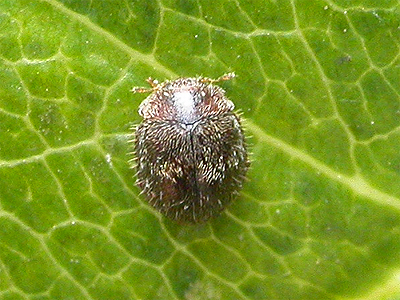 |
|
| ... | ||
| Rhyzobius lophanthae (Blaisdell, 1892) is originally of Australian origin, with the length of the one illustrated being no more than 2.5mm. With a number of records across much of the south of the country, this was a surprise find and is thought the first record for Nottinghamshire. | ||
| Dicyphus escalerae
adults still active into the New Year Probably as a direct consequence of the continued mild Winter weather, adults of the Mirid Bug Dicyphus escalerae (Lindberg, 1934) are still present on Antirrhinum majus growing in a Mapperley garden, with at least four adults found on January 8th. Known from the UK since 2007 and found new to Nottinghamshire at the same Mapperley site in 2018, it seems that adults (and probably nymphs of all stages) are able to remain active throughout the colder months, unless severe frosts occur. This species is probably now quite common in many gardens across the county and is almost certainly much under-recorded. |
||
| An
early July peak for Glow Worm numbers at Clipstone Old
Quarter in 2018 Data resulting from Glow Worm surveys at Clipstone Old Quarter (Sherwood Forest) during the course of 2018, showed a clear peak in female numbers between July 5th and 9th. University students Graham Smith and Harry Huntingdon who conducted the surveys, reported peak counts of 76 females on July 5th, 83 on July 7th and 80 on July 9th. To have three successive high counts over a six day period is unusual and usually indicative of low numbers of males around at the time. Graham and Harry's Clipstone Old Quarter data is enough to make some brief comparison with our own 2018 survey data, from two other local sites at Sherwood Heath SSSI (which had counts of well over 200 females in 2008) and a section of heathland at the RSPB's reserve at Budby South Forest. We visited both sites regularly during the season and recorded a slightly earlier peak in numbers from both Sherwood Heath and Budby SF. Our highest count for Sherwood Heath was of 61 females on July 1st, which coincided with a small peak in numbers of 12 females at Budby SF the same night. Graham and Harry did not survey Clipstone Old Quarter between June 30th and July 3rd, but there was nothing in the numbers recorded before or after these dates, to suggest high numbers had been missed. |
||